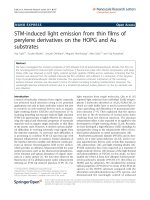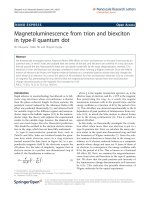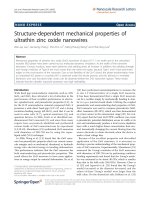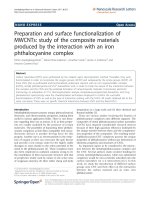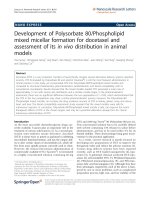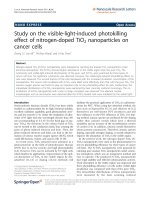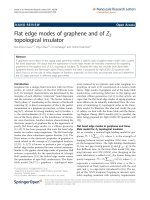Žvátora et al. Nanoscale Research Letters 2011, 6:366 pptx
Bạn đang xem bản rút gọn của tài liệu. Xem và tải ngay bản đầy đủ của tài liệu tại đây (381.97 KB, 5 trang )
NANO EXPRESS Open Access
Polytetrafluorethylene-Au as a substrate for
surface-enhanced Raman spectroscopy
Pavel Žvátora
1
, Pavel Řezanka
1
, Vadym Prokopec
1
, Jakub Siegel
2
, Václav Švorčík
2
and Vladimír Král
1*
Abstract
This study deals with preparation of substrates suitable for surface-enhanced Raman spectroscopy (SERS)
applications by sputtering deposition of gold layer on the polytetrafluorethylene (PTFE) foil. Time of sputtering was
investigated with respect to the surface properties. The ability of PTF E-Au substrates to enhance Raman signals was
investigated by immobilization of biphenyl-4,4’ -dithiol (BFD) from the solutions with various concentrations. BFD
was also used for preparation of sandwich structures with Au or Ag nanoparticles by two different procedures.
Results showed that PTFE can be used for fabrication of SERS active substrate with easy handle properties at low
cost. This substrate was sufficient for the measurement of SERS spectrum of BFD even at 10
-8
mol/l concentration.
Introduction
Surface-enhanced Raman scattering (SERS) has great
potential as an analytical technique based on the surface
enhancement of Raman signals of the molecule situated
on the metal surface w hich is nowadays currently used
for the detection of various analytes at low concentration
[1]. In general, there are two traditional operational
mechanisms to describe the overall SERS effect: electro-
magnetic [2] and chemical [1,2] enhan cement mechan-
ism. Electromagnetic mechanism lies in the enhancement
of local electromagnetic field of incident radiation applied
on the mole cule which is adsorbed on or situated in the
close proximity to rough metal surface. In order to obtain
optimal enhancement of Raman signals of the molecule it
is necessary to use nanostructured surfaces or nanoparti-
cles of noble metals with suitable physical parameters
such as their size, shape, and degree of aggregation [3].
Many different types of SERS substrates, which meet the
above requirements have been developed, including
roughened electrodes [4,5], noble metal colloidal nano-
particles [6,7], silver i sland films [8,9], metal film over
nanostructured surfaces [10,11], acid-etched metal foils
[12], and lithographically produced nanoparticle arr ays
[13,14]. Plastic substrates are also known [15]. Polymers
were commonly used for improved mechanical stability
of nanoparticles [16] and better signal reproducibility via
embossing surfaces and lithographic techniques [15,17].
Polytetrafluorethylene (PTFE) is a polymer with broad
potential applications in microelectronics. Another advan-
tage of this material is its h igh thermal stability and
low degradation due to the exposition to a focused
laser beam. PTFE foil has great surface roughness with
improved adhesive properties of sputtering gold over
layer and can be positive for electromagnetic mechanism.
Gold over layer can suppress Raman background signal
of the PTFE substrate [15].
Within the experiments described in this study we have
prepared suitable SERS active substrates from synthetic
polymer foils of PTFE by deposition of Au layers on its
surface inside of plasma discharge [18]. Electromagnetic
mechanism enhancement was tested on rude P TFE-Au
surface and sandwich structures. The fabrication of sand-
wich structures [19] was realized by incorporating of self-
assembled monolayer of dithiols between the layers of
PTFE-Au surface and Au or Ag nanoparticles.
Experimental
Preparation of gold layer on PTFE foil
The gold layers were sputtered on PTFE foils (2 cm in
diameter) with a thickness of 50 μm.Thetimeofsput-
tering was from 10 to 150 s and deposition parameters
were described elsewhere [20]. Microbalance was used
for gravimetric determinat ion of the amount of sput-
tered gold on polymeric substrate. Continuity of sput-
tered gold layer was determined by measuring of its
resistance by the picoapermeter (Figure 1).
* Correspondence:
1
Department of Analytical Chemistry, Institute of Chemical Technology
Prague, Technická 5, 16628, Prague 6, Czech Republic
Full list of author information is available at the end of the article
Žvátora et al. Nanoscale Research Letters 2011, 6:366
/>© 2011 Žvátora et al; licensee Springer. This is an Open Access article distributed under the terms of the Creative Commons Attribution
License (http://creativecommons .org/license s/by/2.0), which permits unrestri cted use, distribution, and reproduction in any medium,
provided the original work is properly cited.
The influence of time of sputtering (t = 10, 20, 30, 50,
80, 150 s) and concentration (c =10
-2
,10
-3
,10
-4
,10
-5
,10
-6
,
10
-7
,10
-8
mol/l) of used bifunctional compound (biphenyl-
4,4’-dithiol) on the intensity of SERS signals was then stu-
died. In order to study the sputtering time gold layers were
modified with biphenyl-4,4’-dithiol in methanol solutions
(10
-2
mol/l). PTFE foil with gold layer was placed into the
methanol solution for 12 h. After that the foil was taken
outfromthesolution,washed by pure methanol, and
dried on the air. The study of concentration dependence
was similar.
Preparation of nanoparticles
Gold nanoparticles (AuNPs) were obtained by citrate
reduction of K[AuCl
4
] described elsewhere [21]. Silver
nanopartic les (AgNPs) were obtained using sim ilar pro-
cess of AgNO
3
reduction published by Smitha et al.
[22]. Prepared nanoparticles were characterized by TEM
and UV-Vis absorption spectroscopy. UV-Vis absorption
spectroscopy was carried out using a Varian spectrophot-
ometer, model Cary 400 SCAN, from 200 to 800 nm.
The transmission electron microscopy (TEM) images
were recorded using a JEOL microscope, model JEM-
1010 with accelerating voltage 100 kV.
Preparation of sandwich structures
The sandwich structures were prepared by two proce-
dures. In the first one (Figure 2a), the gold foils were
modified by silver or gold nanoparticles previously cov-
ered by biphenyl-4,4’ -dithiol. 1 ml of nanoparticles was
added drop-wise at intensive stirring to the 1 ml o f
biphenyl-4,4’ -dithiol solution with concentration of
5×10
-2
mol/l. The obtained mixture was purified by
centrifugation. PTFE foil with gold layer was placed to
the solution of nanoparti cles for 12 h. After that the foil
was removed from the solution, washed by pure metha-
nol, and dried on the air.
In the second procedure (Figure 2b), PTFE foil with
gold layer modified by biphenyl-4,4’-dithiol was pre-
pared. Then such modified foil was placed into the solu-
tion of 2 ml of nanoparticles for 12 h. After that the foil
was removed from the solution, washed by pure metha-
nol, and dried on the air.
SERS measurements
Raman spectral measurements were performed on Raman
NIR Advantage spectrograph DeltaNu with laser excitation
line 785 nm, power 100 mW in the range of 100 to 2000
cm
-1
with spectral resolution 4 cm
-1
. Integration time was
20 s and results spectra are average of five measurements.
Surface was focused by the NuScope with manual adjust-
ment and field of view was approximately 800 μmat
100 × focal power. All measurements were carried out on
two different places from both sides of PTFE foil.
Results and discussion
Properties of prepared gold layers on PTFE foil
The results of measurements of prepared gold layers on
PTFE foils are shown in Figure 1. The thickness of gold
layer was calculated from the mass difference of foils
before and after sputtering procedure. It is clear from
the table that the thickness is a linear function of sput-
tering time. The value of resistance is related to conti-
nuity of gold layer [18]; therefore, when short times are
applied the resistance values are very high and the layer
is discontinual, while after the applications of longer
times the resistance values change to low which means
that the layer becomes continual.
Preparation of nanoparticles
The average diameter of the prepared spherically shaped
AuNPs electrostatically stabilized with citrate was about
15 nm and for AgNPs was about 45 nm. The wave-
lengths of their surface plasmon absorbance maximums
(AuNPsat520nmandAgNPsat430nm)correspond
well with the averages diameters estimated by TEM
[21,23] (Figure 3).
SERS measurements on PTFE foils
We have chosen biphenyl-4,4’ -dithiol (BFD; Figure 4a)
as compound for the immobilization on the PTFE foil
Figure 1 Dependence of the thickness of gold layer on time of
sputtering (dash line) and resistance values of this gold layer
(solid line).
Figure 2 (a) Preparation of sandwich structures using modified
nanoparticles. (b) Preparation of sandwich structures using
modified gold layer.
Žvátora et al. Nanoscale Research Letters 2011, 6:366
/>Page 2 of 5
with gold layer (PTFE-Au) due to possibility of linking it
into sandwich structures. In contrast to other commer-
cially available dithiols (i.e., ethan-1,2-dithiol, hexan-1,6-
dithiol), BFD has a rigid structure that provides such
orientation on the surface that the possibility of binding
by both of sulfonyl groups is very improbable.
For the evaluation of the dependence of sputtering
time on the quality of SERS spectra we choos e the band
at 1078 cm
-1
due to its high intensity and the possibility
ofeasybaselinecorrection.Thedependenceofareaof
this signal on the sputtering time (Figure 5) showed that
the maximal intensity of SERS signal was achieved using
30 s of the sputtering time (Figure 4b). According to
Figure 1, at this time the layer is changing from discon-
tinuous to continuous (see r esistance). Due to this f act,
when time of sputtering shorter than this is applied, the
surface of gold layer is so much dis continuous that sur-
face enhancement of Raman signals is very small and,
on the contrary, after the application of longer sputter-
ing time, the surface of gold layer is too much continu-
ous, which leads to small enhancement because the
a
b
Figure 3 (a) UV-Vis absorption spectra of the AuNPs and TEM image (in excision); (b) UV-Vis absorption spectra of the AgNPs and
TEM image (in excision).
Figure 4 (a) Raman spectrum of pure BFD; (b) SERS spectrum
of immobilized BFD (c =10
-2
mol/l) on the PTFE-Au; (c) SERS
spectrum of immobilized BFD (c =10
-8
mol/l) on the PTFE-Au
with AgNP (prepared by Figure 2b); (d) SERS spectrum of
immobilized BFD (c =10
-8
mol/l) on the PTFE-Au with AuNP
(prepared by Figure 2b); (e) Raman spectrum of pure PTFE.
Figure 5 SERS spectra of BFD on PTFE-Au for (a) 30 s, (b) 20 s,
(c) 50 s, (d) 80 s, (e) 150 s, (f) 10 s sputtering time. Spectra
were shifted in y-axis.
Žvátora et al. Nanoscale Research Letters 2011, 6:366
/>Page 3 of 5
surface has not got an optimal roughness. The analytical
enhancement factor was calculat ed from the ratio of
band intensity (1078 c m
-1
) of pure B FD solution (c =1
×10
-2
mol/l) in CHCl
3
and BFD (c =1×10
-8
mol/l)
immobilized on PTFE-Au without and with nanoparti-
cles (Table 1).
In the s econd step, we investigated the effect of con-
centration of BFD solution, the type of metal nanoparti-
cles and the effect of their immobilization on the
intensities of SERS signals of PTFE-Au prepared by sput-
tering with the duration of 30 s. The results (Table 2)
show that the maximum intensity of the selected band
was achieved with BFD concentration of 10
-6
mol/l. The
effect of sandwich structure prepared according to proce-
dures which is showed in Figure 2b caused the enhance-
ment of the signal even at lower concentrations, so we
obtained SERS spectrum of AgNPs covered by BFD even
at 10
-8
mol/l (Tables 1, 2; Figure 4c). The signal at 726
cm
-1
(spectrum 4b, 4c, 4d, and 4e) corresponds to defor-
mation vibration of CF
2
group of PTFE. The preparation
of sandwich structures by the other procedure (Figure 2a)
led to obtainment of similar spectra and the influence of
the type of metal nanoparticles was negligible based on
the identical SERS spectral structure. We propose that it
is due to the fact that the concentration of BFD immobi-
lized on the nanoparticles is similar.
It was found that the enhancement of Raman signals
of BFD is i ndependent on the measured side of PTFE
foil due to the transparency of the foil and very thin
layer of sputtered gold. Further, reproducibility of foil
preparation is very high but the reproducibility of BFD-
and NPs-modified foils is lower (RSD = 20%).
Conclusions
In summary, we have demonstrated the possible pre-
paration of SERS active substrate with suitable proper-
ties by sputtering deposition of gold layer on the PTFE
foil. Such foil is cheap, easy to manipulate with it, and
offers the possibility to measure from both sides of
PTFE foil. It was found out that optimum of sputtering
time is for 30 s and the maximum of SERS signal inten-
sity was achieved at 10
-6
mol/l for BFD. With use of
sandwich structures of nanoparticles we were able to
obtain signal even at 10
-8
mol/l. This substrate had the
highest analytical enhancement factor (6.73 × 10
6
).
Abbreviations
BFD: biphenyl-4,4’-dithiol; PTFE: polytetrafluorethylene; SERS: surface
enhanced Raman spectroscopy; TEM: transmission electron microscopy.
Acknowledgements
The financial support from the Ministry of Education of the Czech Republic
MŠMT 6046137307, the GACR Foundation No. 203/09/0675 and GAAV CR
Foundation KAN200100801 is gratefully acknowledged.
Author details
1
Department of Analytical Chemistry, Institute of Chemical Technology
Prague, Technická 5, 16628, Prague 6, Czech Republic
2
Department of Solid
State Engineering, Institute of Chemical Technology Prague, Technická 5,
16628 Prague 6, Czech Republic
Authors’ contributions
PŽ was responsible for synthesis and other characterizations of
nanomaterials (AuNPs, AgNPs and sandwich structures), writing up of this
manuscript and participated in interpretation of experimental data. PŘ and
VP were responsible for recording SERS spectra and interpretation of this
data. JS and VŠ carried out part of the preparation and characterization of
Polytetrafluorethylene-Au substrates. VK is the supervision and participated in
the results, discussion and manuscript revision. All authors read and
approved the final manuscript.
Competing interests
The authors declare that they have no competing interests.
Received: 23 September 2010 Accepted: 28 April 2011
Published: 28 April 2011
References
1. Moskovits M: Surface-enhanced spectroscopy. Rev Mod Phys 1985, 57:783.
2. Campion A, Kambhampati P: Surface-enhanced Raman scattering. Chem
Soc Rev 1998, 27:241.
3. Sant’Ana AC, Rocha TCR, Santos PS, Zanchet D, Temperini MLA: Size-
dependent SERS enhancement of colloidal silver nanoplates: the case of
2-amino-5-nitropyridine. J Raman Spectrosc 2009, 40:183.
4. Jeanmaire DL, Van Duyne RP: Surface Raman spectroelectrochemistry Part
I. heterocyclic, aromatic, and aliphatic amines adsorbed on the anodized
silver electrode. J Electroanal Chem 1977, 84:1.
5. Albrecht MG, Creighton JA: Anomalously intense Raman spectra of
pyridine at a silver electrode. J Am Chem Soc 1977, 99:5215.
6. Kneipp K, Kneipp H, Deinum G, Itzkan I, Dasari RP, Feld MS: Extremely large
enhancement factors in surface-enhanced Raman scattering for
molecules on colloidal gold clusters. Appl Spectrosc 1998, 52:175.
7. Nie S, Emory SR: Probing single molecules and single nanoparticles by
surface-enhanced Raman scattering. Science 1997, 275:1102.
8. Van Duyne RP, Hulteen JC: Atomic force microscopy and surface-
enhanced Raman spectroscopy. I. Ag island films and Ag film over
polymer nanosphere surfaces supported on glass. J Phys Chem 1993,
99:2101.
Table 1 The analytical enhancement factor of the surface
for immobilized BFD (calculated for c =1×10
-8
mol/l);
sandwich structures were prepared according to Figure 2b
Type of surface Analytical enhancement factor
PTFE-Au-BFD 3.89 × 10
5
PTFE-Au-BFD-AuNP 9.12 × 10
5
PTFE-Au-BFD-AgNP 6.73 × 10
6
Table 2 The dependence of the area of the selected peak
1078 cm
-1
in SERS spectra on the concentration of BFD
c (BFD)/
mol/l
PTFE-Au-BFD PTFE-Au-BFD-AuNP
(prepared according
to Figure 2b)
PTFE-Au-BFD-AgNP
(prepared according
to Figure 2b)
10
-2
3.21 × 10
6
1.44 × 10
6
1.86 × 10
6
10
-3
8.37 × 10
6
4.09 × 10
6
6.10 × 10
6
10
-4
5.96 × 10
6
4.12 × 10
6
5.93 × 10
6
10
-5
10.3 × 10
6
8.91 × 10
6
8.04 × 10
6
10
-6
12.6 × 10
6
9.06 × 10
6
4.96 × 10
6
10
-7
6.38 × 10
6
0.709 × 10
6
6.58 × 10
6
10
-8
0.09 × 10
6
0.218 × 10
6
1.14 × 10
6
Žvátora et al. Nanoscale Research Letters 2011, 6:366
/>Page 4 of 5
9. Aroca RF, Clavijo RE: Surface-enhanced Raman spectra of phthalimide.
Interpretation of the SERS spectra of the surface complex formed on
silver islands and colloids. J Phys Chem A 2000, 104:9500.
10. Litorja M, Haynes LC, Haes JA, Jensen RT, Van Duyne RP: Surface-enhanced
Raman scattering detected temperature programmed desorption:
optical properties, nanostructure, and stability of silver films over SiO
2
nanospheres. J Phys Chem B 2001, 105:6907.
11. Bello JM, Stokes DL, Vo-Dinh T: Silver-coated alumina as a new medium
for surfaced-enhanced raman scattering analysis. Appl Spectrosc 1989,
43:1325.
12. Xue G, Dong J: Stable silver substrate prepared by the nitric acid etching
method for a surface-enhanced Raman scattering study. Anal Chem 1991,
63:2393.
13. Haynes LC, Van Duyne RP: Plasmon-sampled surface-enhanced Raman
excitation spectroscopy. J Phys Chem B 2003, 107:7426.
14. McFarland AD, Young MA, Dieringer JA, Van Duyne RP: Wavelength-scanned
surface-enhanced Raman excitation spectroscopy. JPhysChemB2005,
109:11279.
15. Geissler M, Li K, Cui B, Clime L, Veres T: Plastic substrates for surface-
enhanced raman scattering. J Phys Chem C 2009, 113:17296.
16. Jang BSG, Choi D, Heo Ch, Lee SY, Yang S: Nanoscopic ordered voids and
metal caps by controlled trapping of colloidal particles at polymeric film
surfaces. Adv Mater 2008, 20:4862.
17. Linn NC, Sun Ch, Arya A, Jiang P, Jiang B: Surface-enhanced Raman
scattering on periodic metal nanotips with tunable sharpness.
Nanotechnology 2009, 20:225303.
18. Švorčík V, Siegel J, Slepička P, Kotál V, Švorčíková J, Špirková M: Au
nanolayers deposited on polyethyleneterephtalate and
polytetrafluorethylene degraded by plasma discharge. Surf Interface Anal
2007, 39:79.
19. Wang Y, Chen H, Dong S, Wang E: Surface enhanced Raman scattering of
p-aminothiophenol self-assembled monolayers in sandwich structure
fabricated on glass. J Chem Phys 2006, 124:8, 074706.
20. Švorčík V, Slepička P, Švorčíková J, Zehentner J, Hnatowicz V:
Characterization of evaporated and sputtered thin Au layers on PET.
J Appl Polym Sci 2006, 99:1698.
21. Řezanka P, Záruba K, Král V: A change in nucleotide selectivity pattern of
porphyrin derivatives after immobilization on gold nanoparticles.
Tetrahedron Lett
2008, 49:6448.
22. Smitha LS, Nissamudeen KM, Philip D, Gopchandran KG: Studies on surface
plasmon resonance and photoluminescence of silver nanoparticles.
Spectrochim Acta A 2008, 71:186.
23. Žvátora P, Řezanka P, Záruba K, Král V: Binding of selected compounds to
silvernanoparticles. Chem Listy 2010, 104:202.
doi:10.1186/1556-276X-6-366
Cite this article as: Žvátora et al.: Polytetrafluorethylene-Au as a
substrate for surface-enhanced Raman spectroscopy. Nanoscale Research
Letters 2011 6:366.
Submit your manuscript to a
journal and benefi t from:
7 Convenient online submission
7 Rigorous peer review
7 Immediate publication on acceptance
7 Open access: articles freely available online
7 High visibility within the fi eld
7 Retaining the copyright to your article
Submit your next manuscript at 7 springeropen.com
Žvátora et al. Nanoscale Research Letters 2011, 6:366
/>Page 5 of 5

